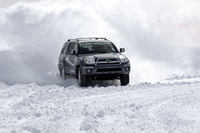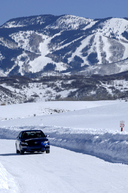Winter Driving Tips From Bridgestone - VIDEO ENHANCED
 |
From driver preparation to seasonal car care, Bridgestone Americas' driving and tire experts have tips to take the stress out of winter driving
NASHVILLE, TN - January 7, 2010: With the onset of winter weather in many parts of the country, drivers are bracing themselves for potentially treacherous road conditions. Bridgestone Americas, Inc. (BSAM), and its team of winter driving and tire experts, is here to help ease some of the anxiety that comes with getting behind the wheel during inclement weather. From how to avoid skidding on icy roads to freeing a car that・s stuck in the snow, Bridgestone provides the information that can help make winter driving enjoyable and hazardfree.
Click PLAY to watch intro video
Mark Cox, General Manager of Bridgestone・s Winter Driving School, offers up these strategic tips to keep drivers and passengers out of harm's way this winter.
• Prepare for winter conditions. Car problems that are a nuisance in the summer can turn dangerous in the winter. A thorough check of the cooling, charging, braking and suspension systems is a must; don't wait until the first winter storm.
 |
• Use winter tires in winter conditions. An all-season tire is a compromise that will not perform as well as a winter tire. Two identical vehicles, one with all-season tires and one with purpose-built winter tires, will have very different performance levels; traction may vary by as much as fifty percent. If your car has all-season tires, remember that the car in front of you may have winter tires and be able to stop up to 50 percent faster.
• Suspension. Shocks and struts are critical to handling, and every bit of vehicle performance helps on ice and snow. Road adhesion is directly influenced by shock absorber or strut performance; worn shocks or struts can cause excessive weight transfer, which reduces the ability of the tires to grip the road.
• Have your battery tested before winter arrives. A dead battery is an annoyance during the summer but can become a life-threatening event in a winter blizzard. Even new batteries can lose as much as 40 percent of their cold-cranking ability in cold weather, and worn batteries lose even more.
• Check exhaust system for leaks. Carbon monoxide is a silent killer. Don't let a simple exhaust leak ruin a trip or endanger the lives of you and your family.
• Winter wiper blades. Replace worn wiper blades with new winter blades. Many drivers replace the wiper blades annually when they put on their snow tires.
• Warm up your car and clear all snow and ice. Visibility is crucial. Safe and responsible vehicle operation requires that front, rear, and side windows are clear. Snow left on the hood will blow onto the windshield and clog wipers as speed increases. Snow left on the roof will blow off and obscure the rear window and the windshield of the car behind. Clearing headlights and taillights will allow you to be seen.
• Check for snow and ice in the wheel wells. Snow and ice in wheel wells could be detrimental to the control and health of your vehicle. Clear out any snow with a durable scraper. To help prevent snow build up on a slushy day spray the wheel wells with silicone.
• Be prepared for anything. Even if you don't become stuck, you may be parked or delayed for extended periods due to accidents, road closures, avalanches or poor visibility. Make sure you are prepared with adequate winter clothes, supplies and emergency equipment. At minimum, carry these essentials items: winter boots, gloves, hats, food, water, cell phone charger, a blanket or sleeping bag, shovel, flashlight (with extra batteries), tow strap, and jumper cables.
 |
• Test road conditions frequently. When driving in challenging conditions, determine how much traction, or grip, is available. Make sure that no one is behind you and hit the brakes firmly until the wheels lock up. This will give you a clear indication of the grip available at that particular point in time. Over the course of a long trip, repeat this test to continually monitor grip.
• Know your car, know your brakes. In everyday driving situations, cars with both antilock brakes (ABS) and traditional braking systems are basically identical. In an emergency stopping situation, two distinctly different techniques are required. With traditional brakes, the cadence, or pumping technique, is effective, but the driver must lift off of the brake if steering is required to avoid an obstacle. The beauty of ABS is that pressing the brake pedal as hard as possible and holding it there allows the computer to pump the brakes while still maintaining some steering effectiveness. Remember that ABS can't perform miracles. If you feel ABS engaging during everyday driving, slow down, because you are exceeding the reasonable speed for the conditions.
• Anticipate difficult situations. Studies have shown that 80 percent of all accidents could be prevented with only one additional second to react. In many situations, this one second can be gained by looking far enough down the road to identify problems.
• Vehicle spacing on the road. Allow plenty of space between your car and other vehicles. It takes from four to ten times more distance to stop on ice and snow than on dry pavement. Following distances should be adjusted accordingly.
• Beware of 'phantom shoulder' on roads. As snow plows clear the roadway, they use a side-mounted 'wing' to push snow well off the side of the road. Many times what appears to be a very wide road or wide shoulder is in fact only snow plowed to the same level as the roadway, hiding steep drop offs. If you must pull to the side of the road, do so slowly and be prepared to steer smoothly back toward the road if the vehicle begins to sink.
• Use grip (traction) efficiently. When roads are slippery, use all of the grip (traction) available for one action at a time. Brake only in a straight line prior to the curve when the car is traveling straight. Taking your foot off the brake before you steer into the curve allows you to use all of the grip available just for steering. Accelerate only when you are able to straighten the steering wheel at the exit of the turn. This technique will allow you to be 100 percent effective at each maneuver: braking, steering and accelerating.
• Be alert at intersections and on hills. Intersections and hills are typically the most slippery portions of the roadway. With numerous drivers braking in the same area, ice becomes ultra-smooth and polished. In the case of hills, drivers may be spinning tires in the same area with an identical result. By identifying these areas, drivers can brake or accelerate in areas that offer better grip, such as in fresh snow, or areas that are not so polished. When stopping on ice, brake harder early and then become lighter on the pedal as the car slows. This allows for precise adjustment in the event that a surprisingly slippery spot is encountered.
• Turn on your headlights. Whenever daytime visibility is less than perfect, turning on your lights allows you to see, and just as important, to be seen by others. Use this rule of thumb: wipers on, lights on. When traveling in snowy weather, remember to clear your taillights, signal lights, and headlamps regularly. High-quality fog lights, mounted low and aimed properly, low and wide, offer a dramatic improvement in low-visibility conditions. Remember to turn fog lights off in city traffic; it・s not practical or polite to leave them on.
• When driving at night. Leave headlamps on low beam when driving in snow and fog. This practice minimizes reflection and glare, improves visibility, and reduces eye fatigue. When oncoming cars approach, focus on the right side of the roadway to help maintain good vision.
• Don't overestimate the capability of SUVs. Many drivers mistakenly believe that fourwheel drive is a cure-all. SUVs do have specific benefits, but they have limitations, as well. Every type of vehicle, regardless of which wheels propel the car, depends on four small contact patches where the tire meets the road for traction. This small contact area is the limiting factor of any vehicle on a slippery surface. Four-wheel drive does not improve braking or cornering effectiveness.
• Learn to read the terrain. Bridges and overpasses ice over faster than normal roads because they don't have the warmth of the earth underneath them. Shady areas cool more quickly than areas in full sun. At dusk or the onset of a winter storm, take notice of areas that never get direct sun and expect ice there. The shadows from large trees, buildings, mountains and even billboards can cause isolated icy spots. With just a bit of practice, drivers can identify these problem spots in advance.
• Rental vehicles are typically equipped with all-season tires, including four- and all-wheel drives. Be advised that an all-season tire, even one with a mud and snow (M&S) rating, is a compromise and will not provide as much traction as a true snow and ice tire. Many drivers mistakenly believe four- and all-wheel drives are all-powerful but remember that they can・t overcome the laws of physics.
• Use floor mats for traction. The floor mats of most vehicles can be used as a tool if you are stuck. Simply turn the mats upside down and place them under the drive wheels as a traction aid.
• Wear quality sunglasses. Good sunglasses help highlight changes in the terrain and road surface even in low-visibility conditions.
About Bridgestone Americas, Inc.:
Nashville, Tenn.-based Bridgestone
Americas, Inc. (BSAM) is the U.S. subsidiary of Bridgestone Corporation,
the world・s largest tire and rubber company. BSAM and its subsidiaries
develop, manufacture and market a wide range of Bridgestone, Firestone and
associate brand tires to address the needs of a broad range of customers,
including consumers, automotive and commercial vehicle original equipment
manufacturers, and those in the agricultural, forestry and mining
industries. The companies are also engaged in retreading operations
throughout the Western Hemisphere and produce air springs, roofing
materials, synthetic rubber and industrial fibers and textiles. The BSAM
family of companies also operates the world・s largest chain of automotive
tire and service centers.


